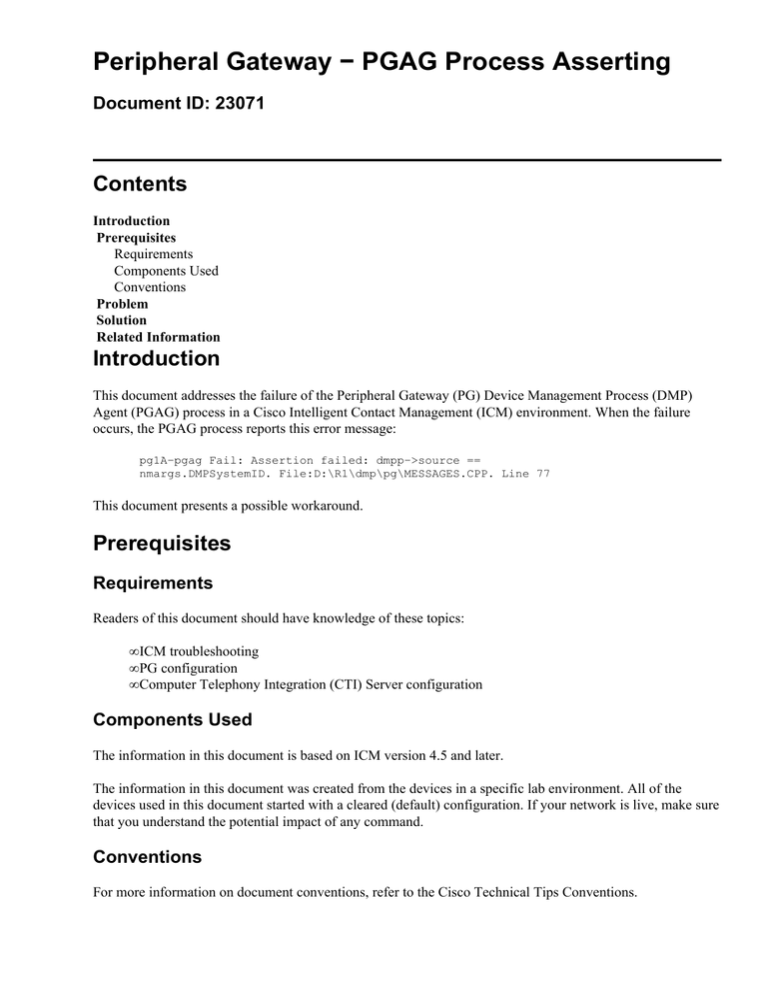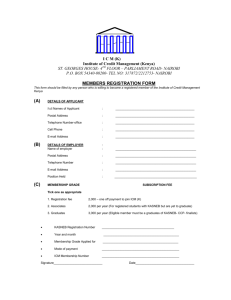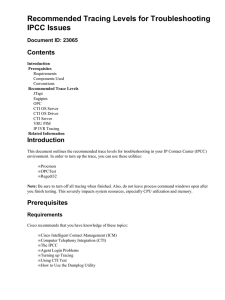
Peripheral Gateway − PGAG Process Asserting
Document ID: 23071
Contents
Introduction
Prerequisites
Requirements
Components Used
Conventions
Problem
Solution
Related Information
Introduction
This document addresses the failure of the Peripheral Gateway (PG) Device Management Process (DMP)
Agent (PGAG) process in a Cisco Intelligent Contact Management (ICM) environment. When the failure
occurs, the PGAG process reports this error message:
pg1A−pgag Fail: Assertion failed: dmpp−>source ==
nmargs.DMPSystemID. File:D:\R1\dmp\pg\MESSAGES.CPP. Line 77
This document presents a possible workaround.
Prerequisites
Requirements
Readers of this document should have knowledge of these topics:
• ICM troubleshooting
• PG configuration
• Computer Telephony Integration (CTI) Server configuration
Components Used
The information in this document is based on ICM version 4.5 and later.
The information in this document was created from the devices in a specific lab environment. All of the
devices used in this document started with a cleared (default) configuration. If your network is live, make sure
that you understand the potential impact of any command.
Conventions
For more information on document conventions, refer to the Cisco Technical Tips Conventions.
Problem
After you start the PG services, the PGAG process immediately recycles itself, and the Peripheral Interface
Manager (PIM) does not become active. In order to view the PGAG process on the PG, look at the process
window or use the Dumplog Utility to view the PGAG log file. The PGAG log has this message:
pg1A−pgag Fail: Assertion failed: dmpp−>source ==
nmargs.DMPSystemID. File: D:\R1\dmp\pg\MESSAGES.CPP. Line 77
Note: This message displays over two lines due to space limitations.
In conjunction with the PG log, the Dr. Watson utility creates a corresponding text file with the name
drwtsn32.log. The file contains this information:
FAULT −>77f7629c cc
77f7629d c3
77f7629e 8bc0
int
ret
mov
3
eax,eax
*−−−−> Stack Back Trace <−−−−*
FramePtr ReturnAd Param#1 Param#2 Param#3 Param#4 Function Name
0012fe60 00406cd4 e101c003 00000000 00000000 00000001 ntdll!DbgBreakPoint
0012fe7c 00402c61 00437898 004378c4 004378e8 0000004d PGAGENT!EMSFailMessage (FPO:
[1,0,0])
0012fea0 004142a5 003f5a01 003f5a30 003f4630 003f5a00 PGAGENT!default_handler (FPO:
[EBP 0x77f05f8d] [2,0,4])
0012fef4 00413d34 003f5a30 00000012 77f8e4f1 0012ffc0 PGAGENT!MDSStopMetering (FPO:
[EBP 0x003f4630] [1,14,4])
0012ff0c 004013da 46d9f530 01c1e21e 000407d2 000c0005 PGAGENT!MDSStartClient (FPO:
[EBP 0x00000012] [0,0,4])
0012ff84 77f8e4f1 7ffdf000 80000003 003009b0 00000000 PGAGENT!main (FPO: [2,15,2])
00000012 00000000 00000000 00000000 00000000 00000000 ntdll!RtlpNtEnumerateSubKey
Note: Some of this code displays over two lines due to space limitations.
For additional information on the Dr. Watson utility, refer to What is a drwtsn32.log File?
Solution
The problem is due to a mismatch between the ICM system ID field and the ID field under the CTI Gateway
(CG) node properties. The CG node properties appear in the CTI Server Properties window when you
configure the CTI Server. The "ICM system ID" specifies the DMP device number of the PG that is
associated with the CTI Server. The "ID" specifies the number of the CTI Server.
This example provides a correct configuration. In the example, the ID field under the PG node properties in
the PG Properties window is PG 1. In this case, the ID field and ICM system ID field under CG node
properties in the CTI Server Properties window must be CG 1 and 1, respectively.
Related Information
• What is a drwtsn32.log File?
• How to Use the Dumplog Utility
• Technical Support & Documentation − Cisco Systems
Contacts & Feedback | Help | Site Map
© 2014 − 2015 Cisco Systems, Inc. All rights reserved. Terms & Conditions | Privacy Statement | Cookie Policy | Trademarks of
Cisco Systems, Inc.
Updated: Apr 28, 2005
Document ID: 23071








